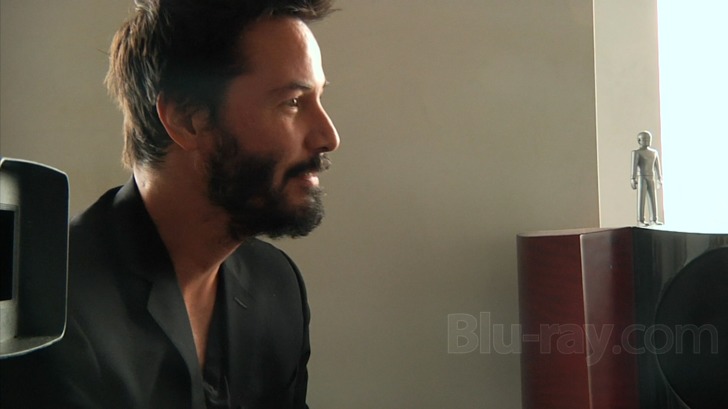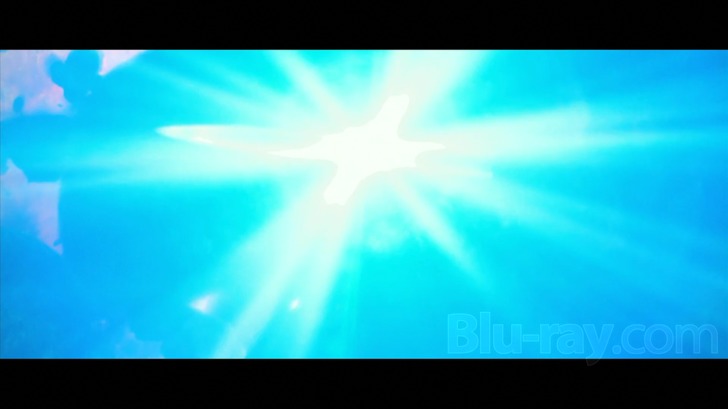Side by Side Blu-ray Movie
HomeSide by Side Blu-ray Movie 
Cinedigm | 2012 | 99 min | Not rated | Feb 05, 2013
Movie rating
7.8 | / 10 |
Blu-ray rating
| Users | 0.0 | |
| Reviewer | 4.5 | |
| Overall | 4.5 |
Overview
Side by Side (2012)
Documentary directed by Chris Kenneally and presented by Keanu Reeves which explores the ongoing debate between traditional celluloid and digital film. In conversation with a number of world renowned directors and industry experts including David Lynch, James Cameron, Martin Scorsese and Anthony Dod Mantle, the documentary tells the story of filmmaking and gives those on both sides of the debate the chance to argue their points and preferences as digital film begins to assert itself as a more cost-effective and accessible means of production.
Starring: David Fincher, Lars von Trier, Christopher Nolan, David Lynch, Robert RodriguezNarrator: Keanu Reeves
Director: Christopher Kenneally
| Documentary | 100% |
Specifications
Video
Video codec: MPEG-4 AVC
Video resolution: 1080i
Aspect ratio: 1.78:1
Original aspect ratio: 1.85:1
Audio
English: DTS-HD Master Audio 5.1 (48kHz, 16-bit)
English: DTS-HD Master Audio 2.0 (48kHz, 16-bit)
Subtitles
English SDH
Discs
25GB Blu-ray Disc
Single disc (1 BD)
Packaging
Slipcover in original pressing
Playback
Region free
Review
Rating summary
| Movie | 4.5 | |
| Video | 4.0 | |
| Audio | 4.0 | |
| Extras | 1.0 | |
| Overall | 4.5 |
Side by Side Blu-ray Movie Review
When is film not film?
Reviewed by Jeffrey Kauffman January 25, 2013When you hear the word “film”, what do you think of? Does it serve as a synonym for “movie” or that older term “cinema”, or does it actually mean the physical celluloid? We have for so long used the term “film” interchangeably for both the physical entity and the viewed product that few probably even think about that disparity and are easily able to discern what is meant from context. But if we’re using “film” to denote “movie” with the implied connection to that physical celluloid, we may be about to enter a brave new world where use of that term in that way is no longer valid. In fact, we are probably already well into a new era, an era which began decades ago with the introduction of videotape and then has exploded in recent years with the advent of HD video and hard drive storage media where nary one frame of celluloid ever passes through an aperture, is never exposed and is never ultimately projected in front of a glaring bulb. Many film (there we go again) lovers who consider themselves relatively well versed in the end product if not the process of filmmaking (see what I mean?) may not care one whit about the differences between “photochemical” and “digital”, and modern day eyes have learned (at least somewhat) to adjust to the different looks of “real” film versus HD video (though I for one am still coming to terms with the sort of flat, textureless and shiny appearance of a lot of Red One shot material). The rush of technology over the past few years especially has left some film (as in celluloid) purists in the dust, but the so-called march of progress seems to be pointing to the eventual demise of physical film for a lot, if not most, new movies, as evidenced by the fact that all major manufacturers of traditional film cameras have ceased production of those units. So where exactly does that leave us?

“Keanu Reeves” and “film historian” may not exactly occur to many film fans (in the same sentence at least), but Reeves is one of the producers of Side by Side, and he conducts the glut of on screen interviews about all of this changing technology with a who’s who of modern day filmmaking talent, Some of the progenitors of the digital age, like George Lucas and James Cameron, are given their due and chime in with their own opinions about why they chose to “go digital” to begin with, but there is equal weight given to those who still at the very least have a certain fondness for actual celluloid, including Christopher Nolan and David Fincher. What is fascinating about Side by Side is the really huge disparity in opinion about whether the onslaught of digital in all sorts of film production craft, from shooting to editing to compositing visual effects, has been a good or a bad thing.
Reeves gives a quick historical overview of photochemical film and its “replacement” (for want of a better term) by digital video. There is some perhaps unintended philosophical issues that are hinted at vis a vis the difference between silver nitrate crystals and pixels, with the first having a changeable, almost infinite, variety, while a pixel count is immutable and finite. And that seems to be an underlying issue, at least tangentially, to what is still tending to keep some artists from completely adopting the digital age, namely the technology’s limitations (part of its “finite” status). Now there are obviously huge limitations to photochemical film, ironically one of the reasons the digital VFX became so popular (since they were easier to craft and composite), but even recent digital cameras don’t have the so-called “dynamic range” (meaning their ability to capture the full spectrum of light) that many directors and cinematographers desire. That, too, is changing for the better (or worse, depending on your point of view), with such films as Collateral exploiting night shoots with digital technology that made things relatively visible that would not have been caught with traditional film.
The interesting thing in all of this is that even the so-called curmudgeons (otherwise known as traditionalists) are more than willing to concede that digital technology has made such things as editing and visual effects much more facile and less time consuming. Old school practitioners of actual “splicing and dicing” film to create edits talk about their initial fear of such systems as Avid, but they now are competent users of the technology, if not exactly vociferous proponents of it.
The other interesting thing here is how instrumental George Lucas has been in any number of digital forays into techniques that were once done differently. But a perhaps unexpected element in this mad rush of technology turns out to be—you and me, everyday consumers who went out and bought the first generation of home video minicams that utilize the same CCD (charge coupled device) that continues to be used in modern day HD video cameras. Some of the first proponents of shooting digitally were younger film aficionados who decided to pick up a minicam and make their own movie.
Side by Side doesn’t really argue for digital technology, but it almost by default makes a case that this now well established sea change is all but inexorable. Reeves seems to be lamenting the death of a communal experience in movie theaters, which is quickly shot down by two filmmakers who not only gave Reeves one of his most memorable roles but took digital effects to heretofore unknown levels in The Matrix films. The Wachowski siblings seem almost fatalistic about the fact that if an old, if iconic, way of doing things is meant to die, it’s going to die. The Wachowskis at least seem to believe that when a celluloid aperture closes, a digital door opens.
Side by Side Blu-ray Movie, Video Quality 

Well, it may be rubbing salt in a wound or adding insult to injury, but all of the contemporary interview segments in Side by Side were shot with either the Canon 5D Mark II (a camera that comes in for some lambasting in the actual documentary) or the Panasonic AG-HPX170. Side by Side's AVC encoded 1080i transfer in 1.78:1 (for the interview segments) therefore has that flat, shiny and textureless look that is so redolent (and for curmudgeon-traditionalists like me, bothersome) of HD digital video. That said, clarity is just fine, colors are accurate looking (no digital intermediate tweaking here, something else the documentary goes into in some detail), and the image has no inherent compression or stability issues other than some fairly prevalent banding that affects both the video interviews as well as some of the film snippets. The rest of the documentary is comprised of numerous archival film and video snippets (all presented in their original aspect ratios, which vary from 1.06:1 to 2.76:1), including a glut of classics old and new (see the screenshots accompanying this review for a smattering of some of the films featured), as well as some really interesting historical video, as in the original Bell Laboratories video that introduced the first digital camera. Some of this source video is obviously in more ragged condition than well curated films, but generally speaking things look very good for the vast bulk of this documentary.
Side by Side Blu-ray Movie, Audio Quality 

Side by Side features a lossless DTS-HD Master Audio 5.1 surround mix (as well as a lossless DTS-HD Master Audio 2.0 stereo fold down). There's really not much surround activity for this track to really exploit, especially since the clips of films which do have fulsome surround soundtracks are typically only seen for a second or two. There's decent directionality in the interview segments (which are actually a bit more apparent in the stereo rendering), but surround activity is mostly limited to the documentary's appealing score by The Ryan Brothers. Fidelity is excellent, with all talking heads coming through loud and clear. Dynamic range (in this case relating to sound, not the light spectrum) is very narrow, as befits this narrated and spoken documentary.
Side by Side Blu-ray Movie, Special Features and Extras 

- Deleted Scenes (1080i; 2:36) is actually called Deleted Scenes Presented by American Express. Corporate branding is at least as prevalent as digital technology, if you ask me.
- Additional Interviews with Filmmakers (1080i; 13:57)
Side by Side Blu-ray Movie, Overall Score and Recommendation 

One of the more piquant comments in Side by Side comes from someone who asks, "Why would I give up my oil paints to work with crayons?" But the fact remains that those crayons are becoming more high tech with every passing day and oil paints are seeming more and more quaint, at least to the under 30 crowd. Whatever (ahem) side of this debate you personally come down on, you owe it to yourself to see this really fascinating and well done documentary. Reeves proves to be an exceptionally astute interviewer, and all of the interview subjects are really interesting and compelling to listen to. This Blu-ray offers good looking (digital) video and agreeable if nonimmersive audio. Highly recommended.
Similar titles
Similar titles you might also like

Citizenfour
2014

Filmworker
2018

Where to Invade Next
2015

Indie Game: The Movie
Regular Edition
2012

A Band Called Death
2012

Stephen Fry in America
2007

Helvetica
2007

The Death of "Superman Lives": What Happened?
Kickstarter Exclusive
2015

Mankind: The Story of All of Us
2012

Lost Soul: The Doomed Journey of Richard Stanley's Island of Dr. Moreau
House of Pain Edition
2014

Raiders!: The Story of the Greatest Fan Film Ever Made
2015

Frozen Planet II 4K
2022

Cleanin' Up the Town: Remembering Ghostbusters
2019

In Search of the Last Action Heroes
2019

Turtle Odyssey 4K
IMAX Enhanced
2018

Armstrong
2019

NOVA: The Planets
2019

Amazing Grace
Aretha Franklin
2018

The Great Buster: A Celebration
2018

Wonders of the Sea 4K
2017